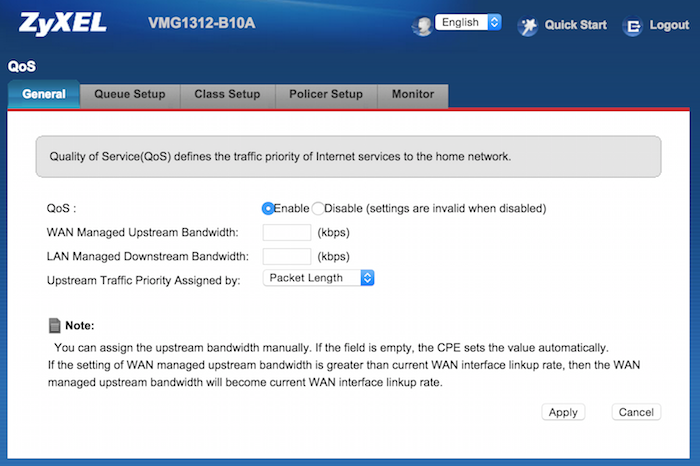VMG1312-B10A: QoS: Difference between revisions
(Created page with "none|frame|Standard QoS enabled, then disabled, then enabled Category:ZyXEL_VMG1312") |
mNo edit summary |
||
| (14 intermediate revisions by 2 users not shown) | |||
| Line 1: | Line 1: | ||
The ZyXEL VMG1312 has QoS enabled by default with a set of default rules giving priorities to various protocols. |
|||
Initial findings show that the default settings may not ideal. |
|||
The examples below are when using the VMG1312 in router mode on a FTTC line. The VMG1312 is plugged directly in to the phone line (via a SSFP), and providing a firewalled, no-nat and DHCP connection to the LAN. |
|||
The QoS settings on the VMG1312 will control the upload traffic. Download is already handle led at the AAISP side where we give priority to small packets as well as the option to rate limit the line slightly to improve performance. |
|||
==The affect of disabling QoS== |
|||
Here we are running a backup job, an rsync (over ssh). Just after 7am QoS is disabled for around 30 minutes. The latency (blue) immediately jumps up to an average of 350ms. It was less than 20ms with QoS enabled. |
|||
[[File:ZyXEL-VMG1312-Qos-OnOff-CQM.png|none|frame|Standard QoS enabled, then disabled, then enabled]] |
[[File:ZyXEL-VMG1312-Qos-OnOff-CQM.png|none|frame|Standard QoS enabled, then disabled, then enabled]] |
||
==Problems with default settings== |
|||
With the default settings, running an rsync over ssh backup, kills DNS lookups completely! SSH has a higher priority than DNS, and with all the SSH traffic DNS lookups can't get a word in edgeways. |
|||
==AA Default VMG1312 Settings== |
|||
We set the QoS be simply based on packet size. We deactivate the various default Classes and Queues and rely on the setting to let small packets jump the queue. This typically gives VoIP, DNS and other 'real time' protocols priority. This is similar to the way that the core routers at the AAISP side work. |
|||
[[File:ZyXEL-VMG1312_QoS_Packet_Size.png|none|frame|QoS setting as set by AAISP, simply based on packet size]] |
|||
===QoS on our CQM Monitoring=== |
|||
[[File:ZyXEL-VMG1312-Affect_of_QoS.png|none|frame|Graph showing affect of enabling the 'Packet Length' QoS. When disabled, high latency and slight packetloss. Once enabled, online activity was unaffected by the 10Mbit/s upload.]] |
|||
With QoS enabled simply based on packet size internet activity is unaffected but a large upload happening at the same time. The example above shows a 40/10 FTTC line with a 10Mbit/s rsync backup upload happening. With QoS disabled there is terrible latency (blue), a small about of packet loss (red at the top) and generally, the internet access is affected quite a lot. With QoS based on packet size enabled, VoIP traffic is unaffected and general internet access such as streaming carries on as normal. The ZyXEL is able to manage the upload as it knows what the speed of the line is and gives priority to small packets which tend to be protocols that require near real-time responses. |
|||
==Customer Feedback== |
|||
We welcome any customer feedback as to these QoS settings. We're happy for customers to modify their config if they would like, but these settings would get overwritten if a config is ever send from the AAISP side to the router. |
|||
[[Category: |
[[Category:ZyXEL VMG1312-B10A|QoS]] |
||
[[Category:ZyXEL VMG3925 B10C|QoS]] |
|||
[[Category:ZyXEL VMG1312 B10D|QoS]] |
|||
Revision as of 08:26, 7 October 2020
The ZyXEL VMG1312 has QoS enabled by default with a set of default rules giving priorities to various protocols.
Initial findings show that the default settings may not ideal.
The examples below are when using the VMG1312 in router mode on a FTTC line. The VMG1312 is plugged directly in to the phone line (via a SSFP), and providing a firewalled, no-nat and DHCP connection to the LAN.
The QoS settings on the VMG1312 will control the upload traffic. Download is already handle led at the AAISP side where we give priority to small packets as well as the option to rate limit the line slightly to improve performance.
The affect of disabling QoS
Here we are running a backup job, an rsync (over ssh). Just after 7am QoS is disabled for around 30 minutes. The latency (blue) immediately jumps up to an average of 350ms. It was less than 20ms with QoS enabled.
Problems with default settings
With the default settings, running an rsync over ssh backup, kills DNS lookups completely! SSH has a higher priority than DNS, and with all the SSH traffic DNS lookups can't get a word in edgeways.
AA Default VMG1312 Settings
We set the QoS be simply based on packet size. We deactivate the various default Classes and Queues and rely on the setting to let small packets jump the queue. This typically gives VoIP, DNS and other 'real time' protocols priority. This is similar to the way that the core routers at the AAISP side work.
QoS on our CQM Monitoring
With QoS enabled simply based on packet size internet activity is unaffected but a large upload happening at the same time. The example above shows a 40/10 FTTC line with a 10Mbit/s rsync backup upload happening. With QoS disabled there is terrible latency (blue), a small about of packet loss (red at the top) and generally, the internet access is affected quite a lot. With QoS based on packet size enabled, VoIP traffic is unaffected and general internet access such as streaming carries on as normal. The ZyXEL is able to manage the upload as it knows what the speed of the line is and gives priority to small packets which tend to be protocols that require near real-time responses.
Customer Feedback
We welcome any customer feedback as to these QoS settings. We're happy for customers to modify their config if they would like, but these settings would get overwritten if a config is ever send from the AAISP side to the router.


